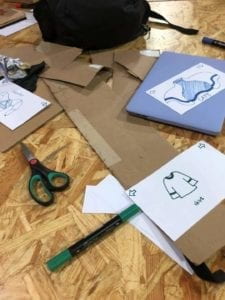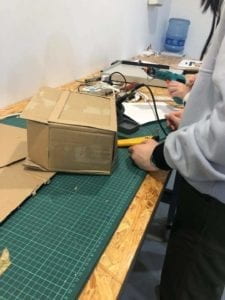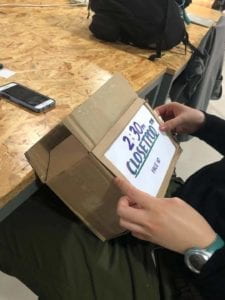Our idea of interaction was very simple, but had to fulfill certain key requirements. The first requirement is that there must be at least two actors in an interaction. The second is that the two actors must be taking turns in engagement and must be reacting according to what the other is doing. Lastly, there must always be a variability of outputs that vary depending on the input from the other actor.
Alias is a great example of interaction because it checks all these boxes, and more. The actors are clearly the humans and their personal parasites, and they both take turns in engaging with each other. For example, the human asks a questions and then waits for a response, or the human gives a command and waits for confirmation. The output variety of what Alias says is also shown in the video, as it only reacts to the given name you assign it. This allows the interaction to be different for all owners. An example of non interaction would be the EM table, where the actors are not interacting with each other. In short, the EM table, when turned on, transmits a small electromagnetic field around its center with the ability to power a low energy demanding light. This fails all of the check boxes, expect maybe having more than one actor, and also this aligns more with begin a battery source than interaction. If you consider this interaction, does charging your phone count as interaction too?
Using the above examples, we tried to incorporate the Alias style of interaction into our product. Our product the ClosetPod is interactive in more than one sense. Firstly, the first interaction is between the ClosetPod tablet and the person who owns it. This is because the ClosetPod not only can differentiate people with face identification, but also different people have different styles of clothing that they would install into their ClosetPod. The adaptive clothing that comes out of the Pod is also interacting, depending on the temperature and moisture of the atmosphere, it changes itself accordingly (like how our shirt became a raincoat in the rain) to fit it. How humans interact with the ClosetPod is similar to how you interact with your phone, where you request something and the tablet responds back. You would verify your face, the ClosetPod would confirm that face is yours, then you would go through your options of clothing and eventually pick one, where then you would wait for your ClosetPod to materialize it. Finally, the output of the ClosetPod, whether it being the clothing it materializes or the face it recognizes, is all dependent on the human user. This is due to the vary tastes of clothing and faces in humans, all of which are different variables that are taken in account that leads to different outputs.
The hardest task we had was definitely finding a way to present all the forms of interaction that the ClosetPod had to offer. Our group met up multiple times to discuss our skit because while we felt that we had a simple idea, expressing the many variables would be complicated. Eventually we decided that we could frame the product in a skit that is sort of a satire of our current lives. The idea being that 100 years later our technology is so advanced, but yet we still have not solved issues like global warming or poverty. We borrowed the idea of “broke” from the current Apple Airpods, where it is commonly joked that whoever has them are separated in social classes with others that do not possess them. This is due to the fact that these ear pods are ridiculously expensive, so the idea is that if you possess them you must have a lot of disposable income. Airpods are merely a convenient product, and I bet 100 years prior no one could ever imagine we would make them one day. This same concept is with the ClosetPod where it is merely a convenience.
All in all, we felt that we did a decent job at presenting our ideas, but there are a few things we could have improved in. The design in our product was something we could have definitely spent more time on. I think the cardboard box we used may have confused people because people are not used to tablets being that large and wide. Secondly, our skit could have put more emphasis on how interactive we truly imagined our product to be. And finally, I felt that the transformation of the tiny Airpod container into the large box might have been missed by a few people. We probably could have put more emphasis on that also. In conclusion though, this project has taught me a lot about interaction and makes me excited to looking towards our midterm and finals!
Here are some of photos of the skit and product making process:






Sources: